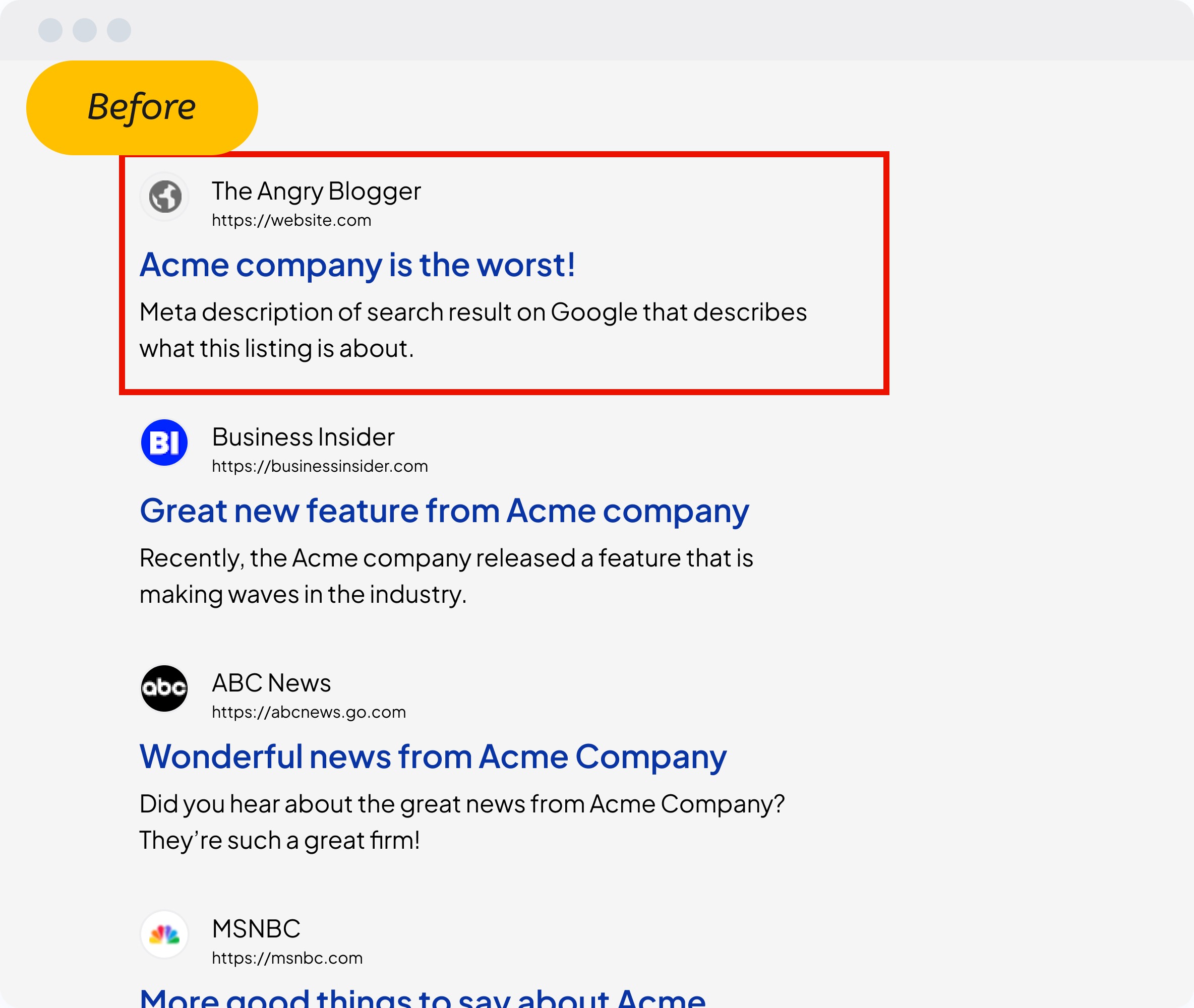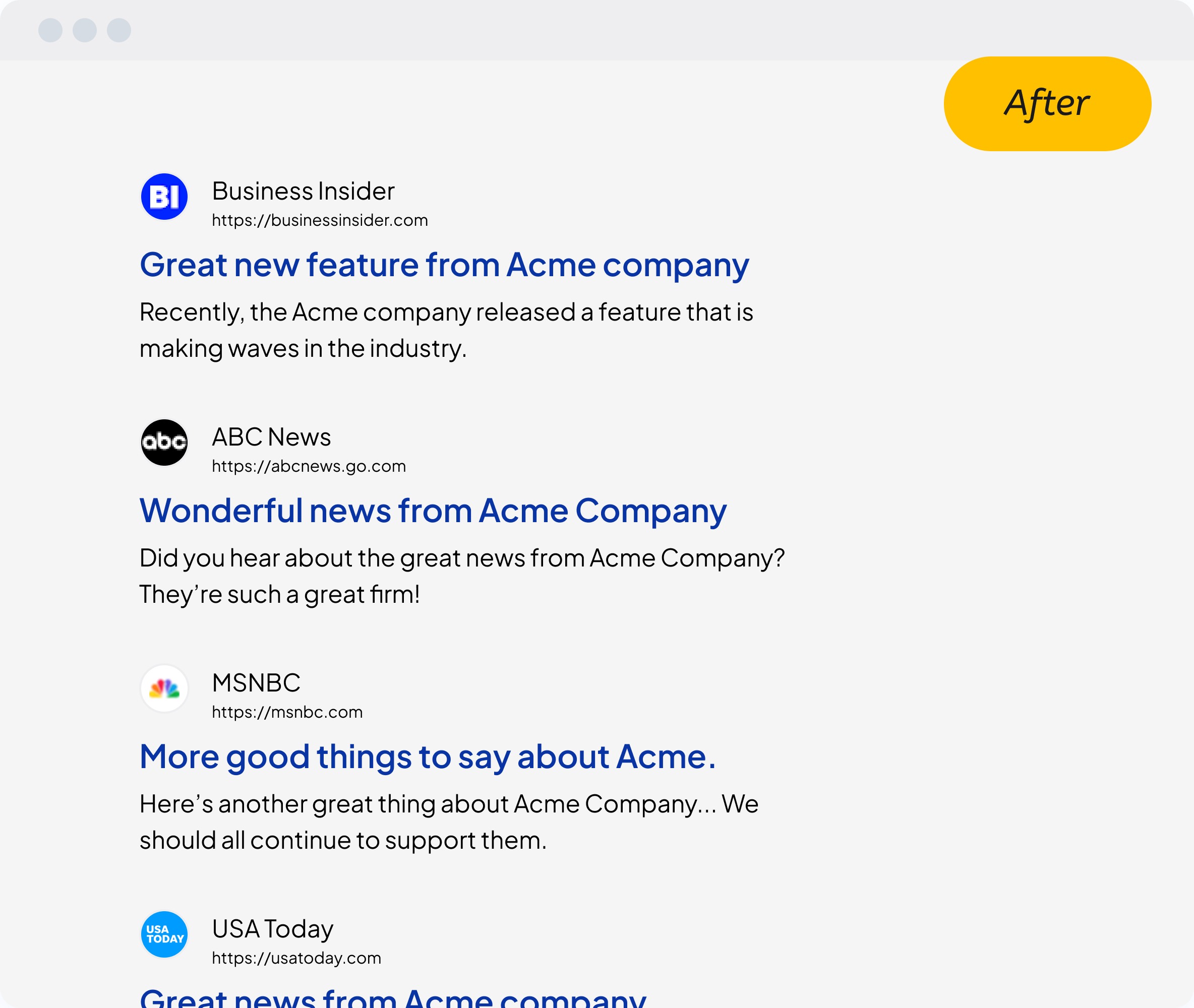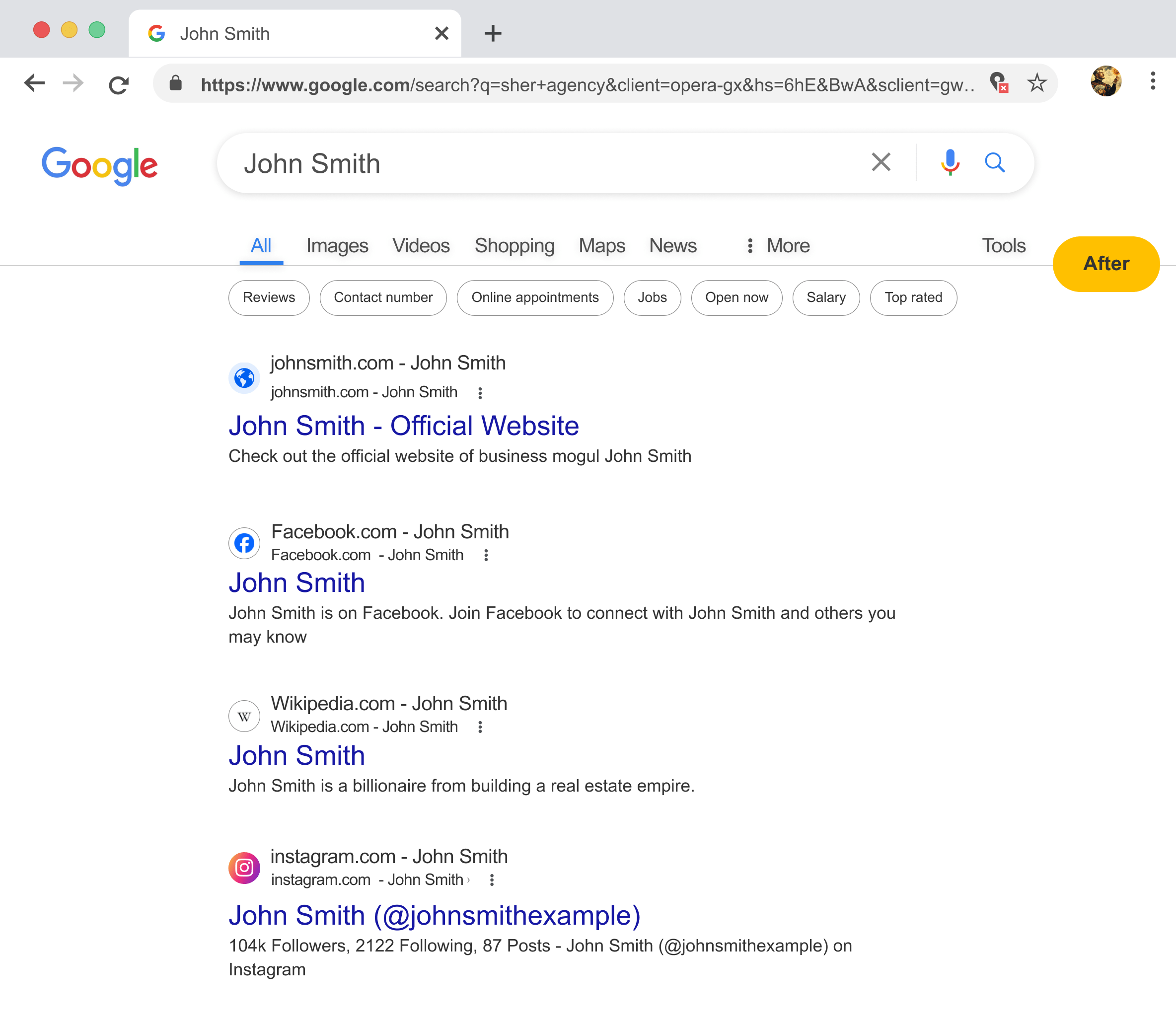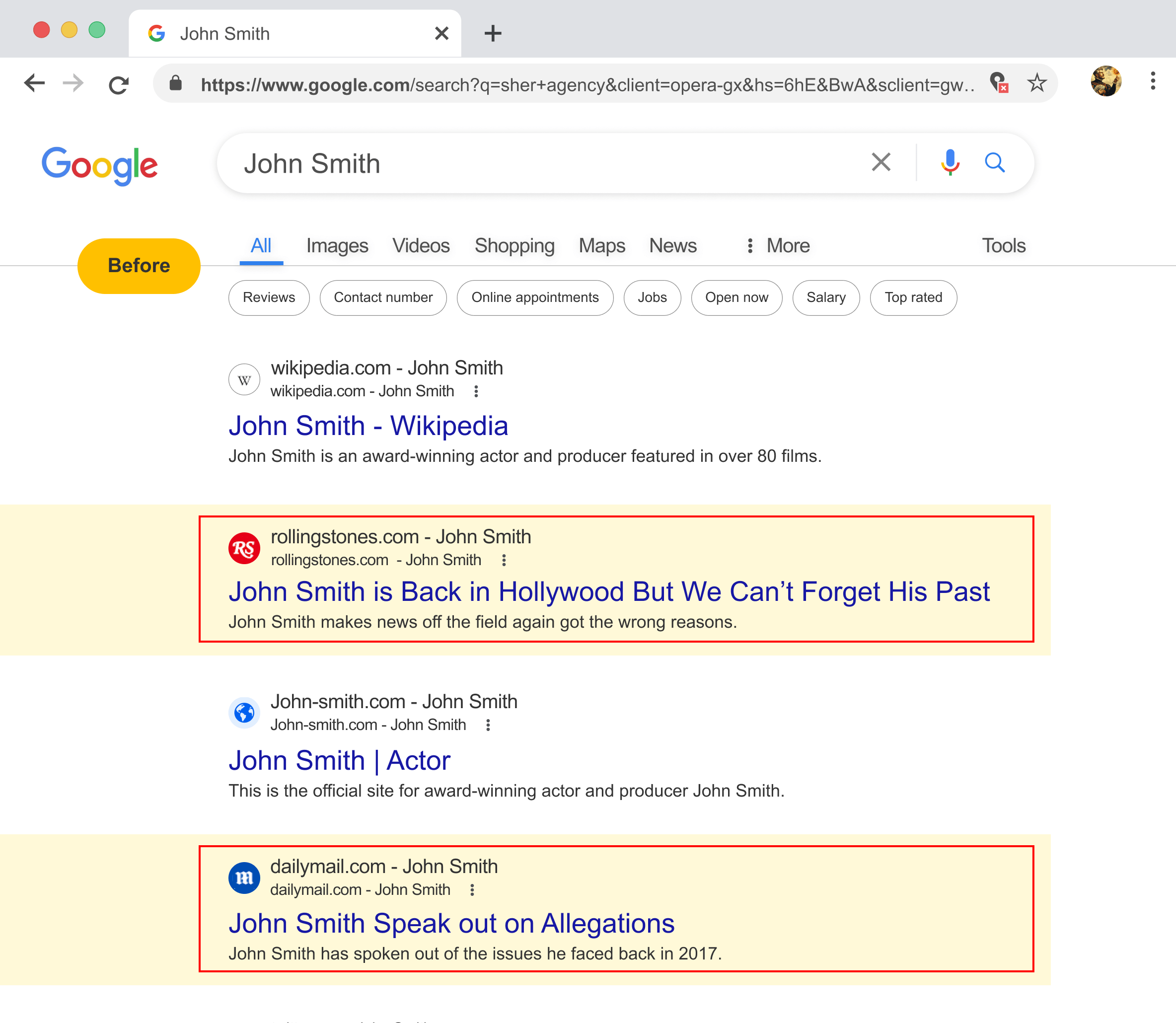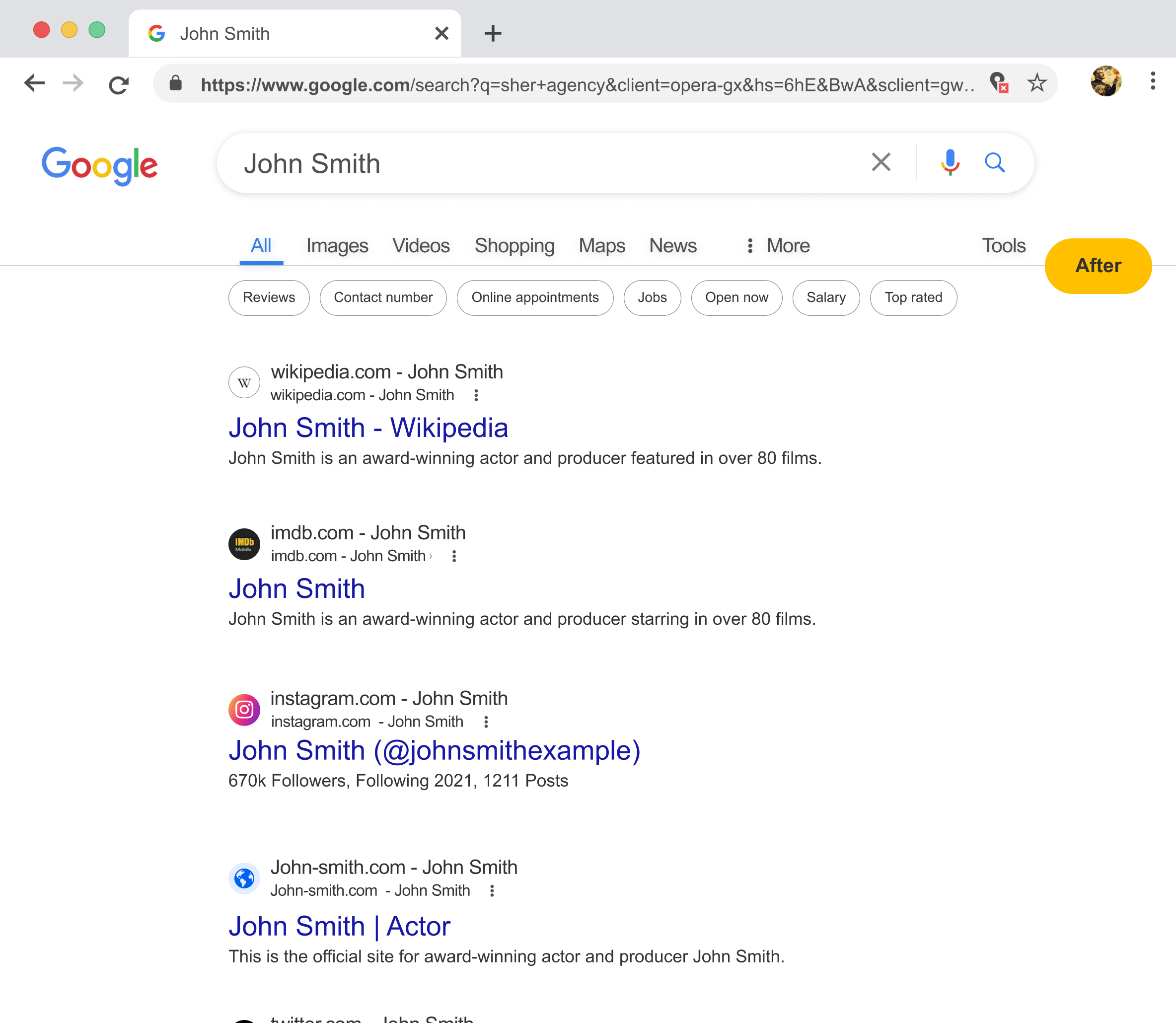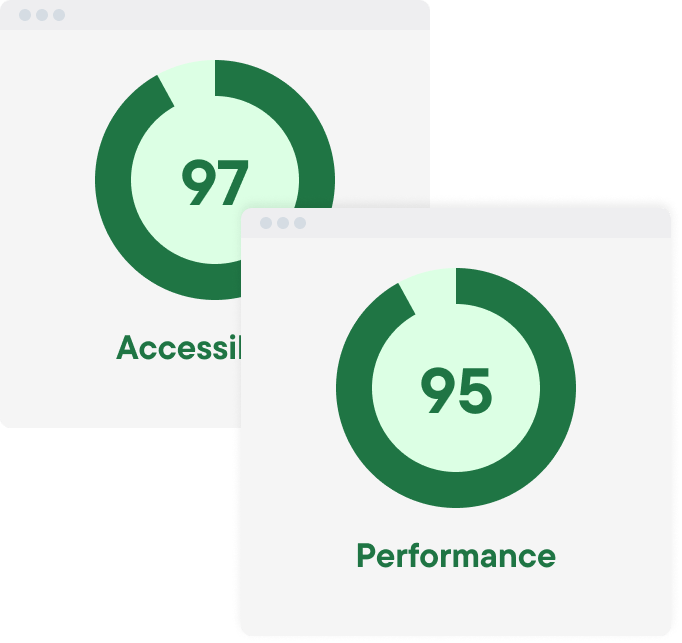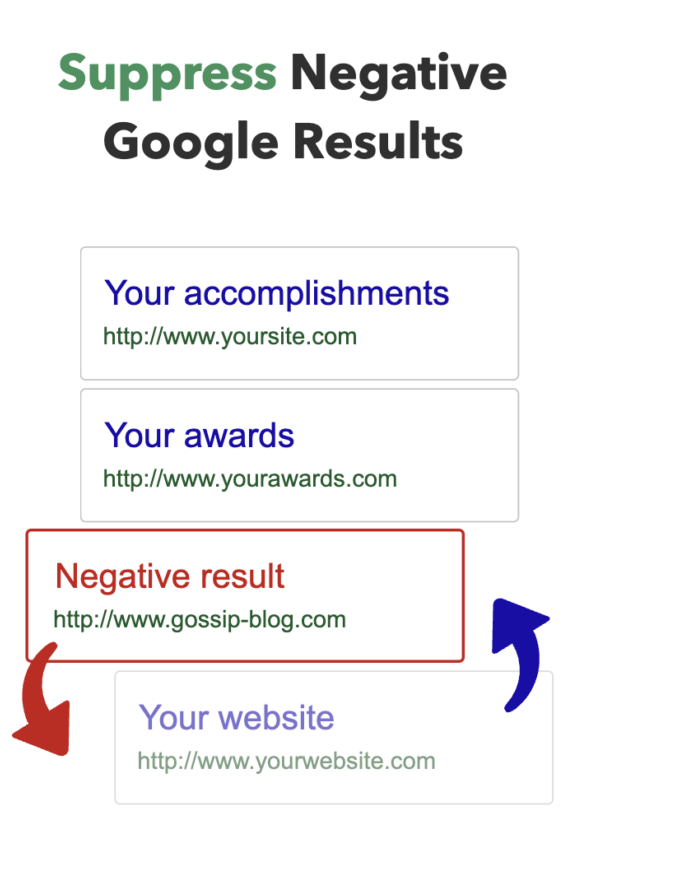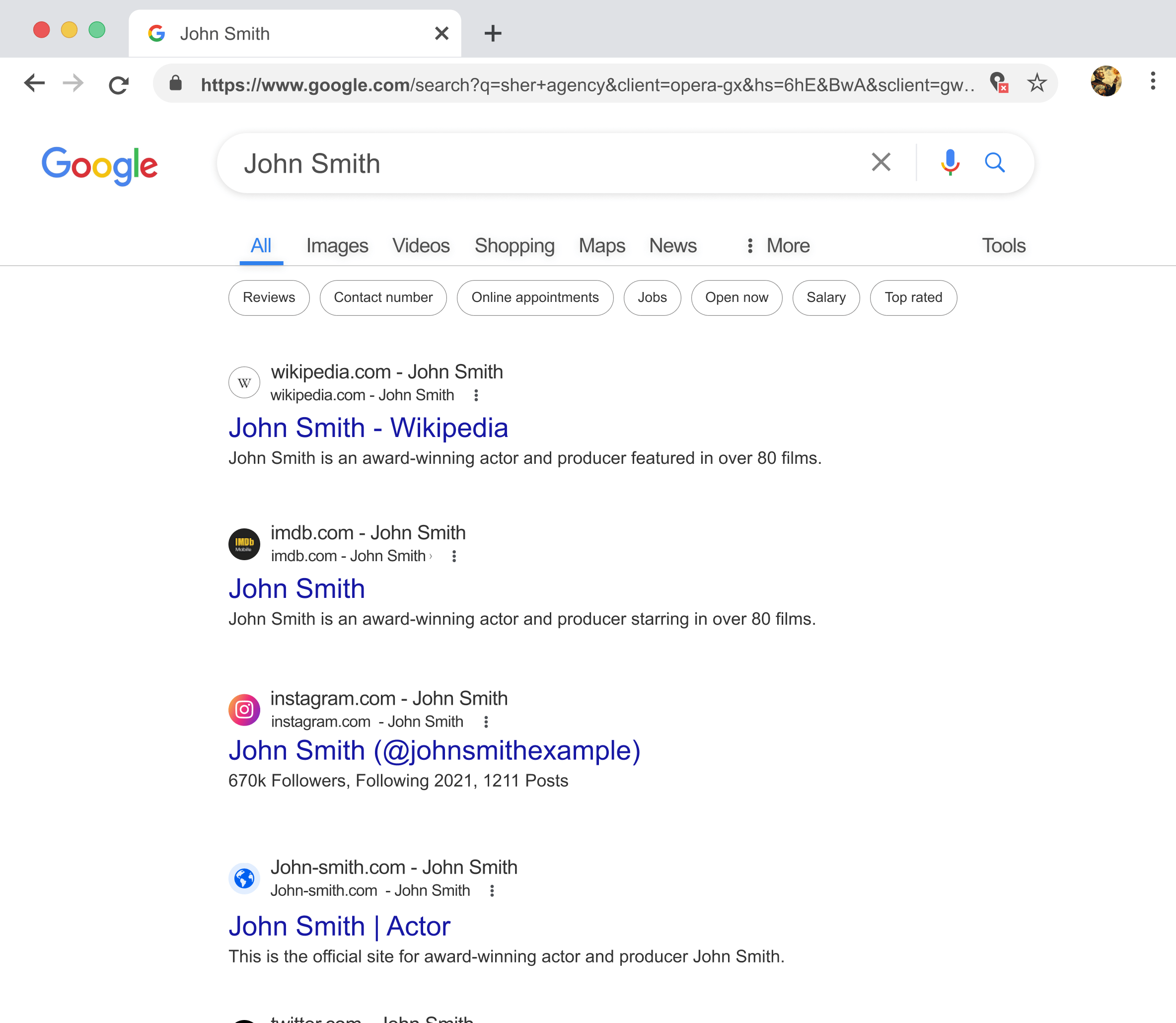What is Online Reputation Management?
Online reputation management (ORM) is a strategy that monitors and controls your online image. Its goal is to create a positive public perception and push negative media out of the public eye. ORM is also commonly referred to as internet reputation management (IRM) or digital reputation management (DRM).
The goal of ORM is to empower you to control your own online narrative by dominating the search results, controlling the social media discussion, and preventing negative content from harming your business.
ORM strategies include running paid ads, responding to negative reviews, publishing positive news stories in trustworthy publications, optimizing social profiles, and working with influencers to promote your brand’s positive aspects.
Again, ORM always comes back to you controlling your narrative.
There are three main types of online reputation management:
- Proactive reputation management: This type of ORM focuses on building a positive image of your brand online to protect you if something bad happens. This includes improving Google results, posting on social media, and staying engaged on review websites like Trustpilot.
- Customer review management: This is when you actively respond to positive and negative reviews to foster trust and build your brand image.
- Reactive reputation management: Reactive reputation management is when someone posts something negative or unfair about you, and you respond by addressing the situation, taking control of the narrative, and publishing mass amounts of positive media to push it out of the spotlight. When done right, the favorable news will overwhelm anything negative and your life and business will get back to normal. Keever SEO specializes in neutralizing negative media about your brand and putting an end to your PR crisis.
According to Google’s Think With Google platform, more than half of consumers search a product or service on Google before buying. Managing your online reputation ensures they see you in the best possible light when they do.
When done properly, ORM enhances your brand image, fosters trust, and improves customer conversions by promoting positive information about your brand while suppressing slander, misinformation, or negative reviews.
Why is Online Reputation Management Important?
Online reputation management is important for two key reasons: it drastically improves the chances that a customer will do business with you AND it protects you from potential ruin.
It only takes one negative review, piece of bad press, or unfair accusation to completely ruin a person’s or brand’s reputation these days.
Creating an ironclad positive image of your brand across the web increases conversion rates, enhances trust, and even boosts search engine rankings.
According to the PricewaterhouseCoopers study “Experience is Everything: How to Get it Right”, 60% of consumers will not buy from a brand that comes across as untrustworthy.
I routinely work with celebrities, athletes, and 7-figure entrepreneurs who tell me that unfair online press is taking hundreds of thousands of dollars in business from them. As soon as someone Google’s their name or business, they immediately build a negative opinion. This ruins the sale.
ORM drastically improves your chances of converting customers by making your personal brand or business appear as trustworthy as possible.
And remember, online business is a zero-sum game: any negative press about you helps competitors. When a potential customer sees negative information about you on Page 1, you’ve just lost a sale to someone who has a better brand.
Here’s a very basic example:
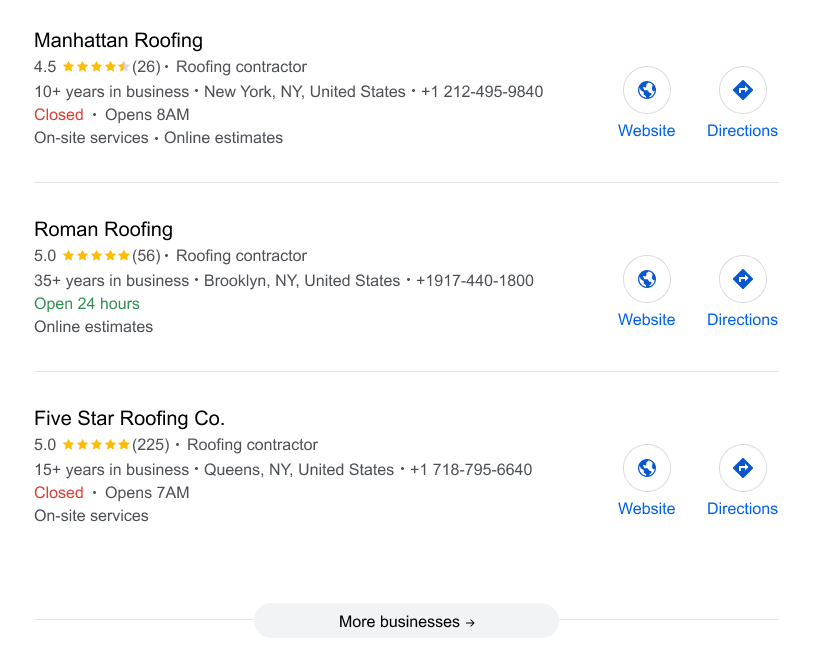
In this local search for a roofing contractor, “Manhattan Roofing” is missing out on potential customers simply because their competitors have more reviews and better ratings. This is the importance of ORM in a nutshell.
Let me elaborate a bit more on the benefits of ORM before we get to more important issues after.
Think With Google claims that more than 80% of consumers search online before visiting a store and more than half search Google before doing business with an online brand.
I tell this to all of my ORM clients here at Keever SEO: You need to control your narrative online so you look your best when it matters most.
The benefits of online reputation management include:
- Improving conversion rates by appearing more trustworthy
- Reducing the chances that negative press gains visibility
- Increasing brand awareness by making you more visible in key places
- Optimizing your business by seeing what customers dislike the most and fixing it
The importance of ORM is clear: Look your best when customers search for you online during their decision-making process.
But even more important than that are the dangers of NOT practicing ORM.
The internet has changed the reputation game. Once something negative is said, it only takes a split second for it to grow into a negative PR wildfire.
If you don’t control your narrative, this could lead to:
- Lost sales: Customers who search for your brand will almost certainly not do business with you.
- High costs: It’s much easier to proactively build a positive reputation than it is to repair a damaged one. If you’re in the middle of a media storm, it’s a lot of work to climb out.
- Crisis and ruin: Individuals, brands, and Fortune 500 companies have all been ruined by public relations crises (I’ll cover a few down below).
- Difficulty attracting talent: Skilled employees almost always search for potential employers online. If your company is seen as a poor place to work, this could influence their decision.
- Difficulties with sponsors and partners: Other companies will hesitate to do business with a brand or individual with a negative online reputation.
An Example of Online Reputation Management in Action
I want to show you a good example of online reputation management done the right way, so you can see how powerful it is when done properly.
I approach things from a search engine optimization (SEO) perspective (I’m an SEO at heart). Good digital reputation management isn’t much different from good SEO when you think about it.
When people search for a keyword, you want your result to be at the top. Same with ORM: When people search your brand, you want YOUR positive media at the top, not someone else’s negative spin.
The goal with ORM is to have a clean and positive first page of Google results. This is priority #1
I’ll show you good ORM in action using the person I know best: Myself.
Let’s start with a Google search:
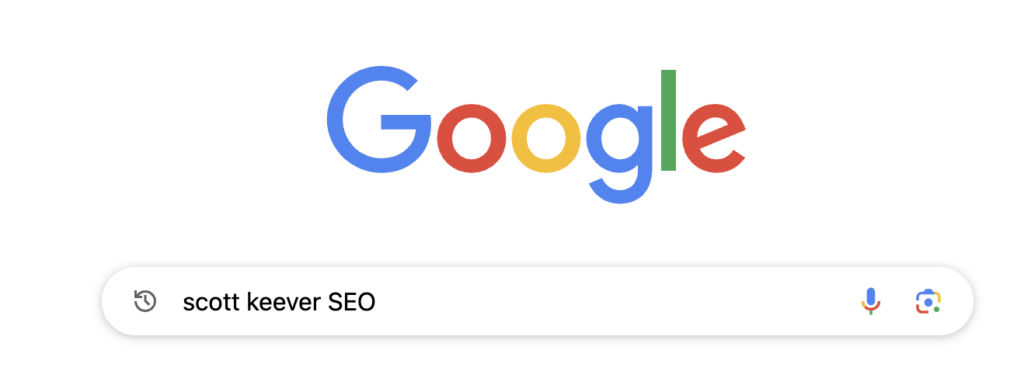
I Google myself way too often – and not just for digital PR purposes!
Here’s what comes up on Page 1 for my brand:

I’ve painstakingly built a fortress of positive assets that paint me in a positive light. In other words, I’m in total control of my online narrative. And notice important reputation-related words like internationally recognized, fastest-growing, award-winning, etc.
You can also see proactive online reputation control in action when you Google my name plus “reviews”:

Examples of ORM Failures (And What They Did Wrong)
The following online reputation management failures will help you better understand why ORM is so important. And, once you see where these companies went wrong and what they should’ve done, you’ll be better able to protect your internet reputation.
The following catastrophes can teach you what NOT to do, and, more importantly, what to do in the event of a disaster.
JPMorgan’s “#AskJPM” Disaster
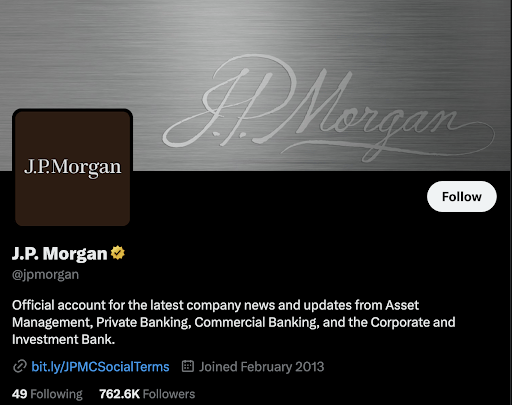
The #AskJPM Twitter disaster was a public relations campaign by JPMorgan Chase in 2013 that was an attempt to improve public perception of the company after the financial crisis and rising concerns regarding their social responsibility practices.
JPMorgan initiated a Twitter Q&A with top executive Jimmy Lee hoping to address public concerns and improve corporate transparency.
This turned into an ORM failure of epic proportions.
Instead of an open and honest talk with potential customers, it became a barrage of negative tweets and trolling that forced the company to shut down the Q&A and go into damage control mode.
What Went Wrong?
JPMorgan Chase failed to analyze public sentiment and create a crisis management plan in case of overwhelming negativity. Had they used any type of review or public sentiment analysis tool, they could easily have predicted that more than 65% of responses would be negative.
Instead, they went into a dangerous PR situation without any analysis or plan.
The result? A PR disaster.
Lesson Learned: Analyze public sentiment to close the gap between how YOU perceive yourself and how YOUR CUSTOMERS perceive you.
American Airlines Customer Response ORM Failure
Responding to customer complaints is one of the most basic ORM strategies. However, when done wrong, it can turn into a PR nightmare. American Airlines learned this the hard way when a disgruntled customer sent them an email and their automated response replied “thank you for your support”.
What Went Wrong?
The reply quickly spread around the web and made the airline look foolish at best and negligent at worst. This led to an attack where their reputation was called into question.
There were even negative comments on industry forums like this:

Lesson Learned: Put in the effort to have a real human being respond to upset customers with an apology, address their concerns, and provide a solution to the problem. And, if you’re going to automate your ORM strategies, do it the right way!
Nestlé
Nestlé is the world’s largest food and beverage company, so you’d think that they’d be immune to an online reputation crisis.
Not true at all.
The Swiss multinational food and drink corporation faced a massive brand reputation management crisis when Greenpeace attacked them over their environmental policy.
This led to users attacking the company’s reputation on social media and even changing their profile pictures to anti-Nestlé slogans.
What Went Wrong?
Nestlé made a major blunder with their brand image by attacking consumers and Greenpeace instead of holding themselves accountable and finding a happy middle ground.
They even went as far as trying to have YouTube videos removed and threatening consumers who used their logo with lawsuits.
This poured fuel on an already burning hot PR fire. According to a Boston University study “Greenpeace, Nestle, and the Palm Oil Controversy”, this eventually led to a sharp drop in Nestlé’s stock price.
Lesson Learned: ORM Rule #1: Don’t fight with your customers. And ORM rule #2: Always have a crisis mitigation plan. When disaster strikes, you should always hold yourself accountable if it’s true and begin a positive PR campaign to repair your image. NOT blame consumers and threaten them.
How Does Online Reputation Management Work?
Online reputation management requires initial strategizing and goal setting, auditing your current online reputation, developing a long-term strategy, and consistent monitoring to ensure your reputation isn’t tarnished.
When these strategies are used together, they protect your public image by:
- Letting you keep control of the narrative and building a reputation that reflects your brand strengths
- Building a strong fortress around your name that protects you from bad press
- Utilizing the right media channels to connect with your audience
- Strengthening your internet reputation by encouraging customers, journalists, and large websites to publish positive reviews/information about you
- Monitoring and responding to bad press or reviews as quickly as possible, ensuring they do the minimum amount of damage
I’ve used the same ORM process repeatedly at Scott Keever SEO to get great results. My online reputation management strategy typically works like this:
- Decide what you want your image to be: The first step in solidifying your online reputation is deciding exactly what you want it to be. You want your reputation to be positive. But which points exactly do you want to highlight? Your customer service? Your expertise? The quality of your products? Think back to my personal example. I want to be seen as an SEO and ORM expert. That helps guide me on which assets to build, what to say, and where to publish content.
- Audit Your Online Reputation: Conducting an online reputation audit helps you create a guide for further actions in protecting and enhancing your reputation. During an audit, we analyze public sentiment, create a baseline for your reputation, uncover negative press, and benchmark you against competitors. This includes analyzing the SERP, checking mentions of your brand, coloring customer reviews (what’s their general sentiment?), and seeing where people are discussing your business. We’ll check Google, social media, media sites, and review aggregators. The benefits of an online audit include seeing where your reputation stands, uncovering hidden issues, identifying opportunities for improvement, and preventing crises.
- Develop a Content Strategy: Once we know where your online reputation stands and where we need to promote your brand, the next step is to develop a content strategy that builds positive assets in the right places. This includes guest blogging on major websites, building high-value profiles on the right platforms, improving reviews on major sites, and optimizing existing assets to say what you want them to say. It also includes developing a social media strategy that builds a dedicated following. By the way, social profiles can rank on Google, too. You’d much rather a potential customer find an optimized social profile with positive content than a piece of misinformation or a negative review.
- Publish Content Consistently: Publishing consistent content on the web solidifies your image in Google’s eyes. We will regularly publish consistent content about our client to “train” Google’s algorithm on who you are and what you do. The more positive signals we send to Google, the more it trusts that content over less-consistent harmful content. The result? It ranks positive articles on top, and the negative ones move out of the spotlight.
- Set up Monitoring: The key to success with ORM is being constantly aware of everything that’s said about you or your business online and responding ASAP. We’ll set up monitoring tools like Google Alerts and BuzzSumo to keep our ears to the ground at all times, so we can prevent damage before it even happens.
- Respond to Reviews And Press: You need to respond to reviews and press (and constantly maintain your reputation in general) because customers appreciate it. Timely and empathetic responses to reviews not only help win new business, but they could even get the negative review removed. 53% of customers expect a business to respond to negative reviews in a week or less, according to TrustPulse’s study entitled “Online Review Statistics”.
The Best Online Reputation Management Media Channels
If you want to build a positive image for your brand online, the only option is to dominate the top online reputation media channels.
ORM requires building positive assets across various channels including Google, social media, paid advertising, earned media, and owned media.
The top online reputation management media channels we work with are:
Paid Media (Ads, Sponsored Posts, And Influencers)
Paid media is the fastest and most impactful online reputation management media strategy. Another name for paid media is paid placement.
This must be the key area of focus right off the bat.
The biggest benefit for you is that you can control the messaging and get right in front of your audience on their preferred platforms. The downside is that modern consumers are skeptical of brand-controlled media, which is why it’s so important for you to solidify your messaging and increase credibility through multiple channels.
Paid media includes direct advertising such as:
- Ads: Paid media lets you place ads on Google, social media, and other platforms that appear at the top of the search or directly in the user's feed. For example, you could use ads to address concerns or promote positive content like testimonials or case studies. They also help ensure that customers find your website on the results page first rather than a negative article or review site. The more ads you run the more space you take up on the first page of Google. This pushes negative content further down, and since most users are too lazy to scroll, they’ll only see the positive content up top.
- Sponsored Posts: Sponsored posts for online reputation management are a paid media tactic where you pay for articles on major publications to highlight positive stories, customer testimonials, rebuttals to negative criticism, and awards or recognition.
- Influencers: Influencers are a major asset in the ORM world. We use influencer marketing to leverage their credibility and highlight positive experiences with you and improve your reach on social media and Google.
Earned Media
Earned media is a type of media channel in ORM where you gain publicity through “organic” media coverage rather than paid advertising.
The most popular types of earned media my clients use are:
- Press coverage (eg., press releases)
- Blog posts on popular websites
- Forum posts (e.g, industry forums or Reddit)
- Customer reviews on review aggregators (e.g, Trustpilot, Google, or Yelp)
- Social media mentions
Earned media is an invaluable asset in ORM because it’s perceived as more authentic and has higher engagement levels than paid media. However, it’s more difficult to obtain and takes more time than paid channels.
Here’s an example of earned media in ORM from Glassdoor where a former employee left a 5-star review for my brand:
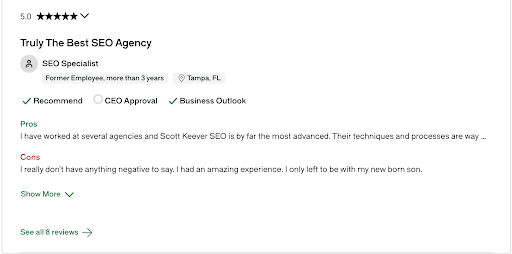
Pro Tip: The easiest ways to obtain more earned media quickly are by requesting positive reviews from existing clients and regularly publishing press releases. You can also use sites like MuckRack and Prowly to reach out to independent journalists for unique coverage.
Social Media
Social media or shared media is an internet reputation management channel that involves posting positive content about your brand on social platforms such as Facebook, Google Reviews, Instagram, and other industry social platforms.
According to one Amazon Web Services study called “Tracking the Digital Payments Takeover”, more than 40% of consumers use social media to find products or services.
Any negative sentiment on social media is harmful and a major turnoff for potential customers.
Types of harmful media include:
- Negative comments on your business page
- Poor review ratings on your social pages or aggregators
- Unaddressed complaints
- Negative media being shared on Facebook feeds or Instagram stories
I find that most businesses neglect their social media and focus too much on posting promotional materials on their accounts instead of improving their image as a whole.
This is not enough to maintain your brand image in the current market.
Anyone can say anything they want about you with 0 repercussions. Before you know it, their friends know. Then friends of their friends know. Next thing you know, your reputation is ruined, and the only way out is a reactionary PR campaign.
Thankfully, there are a few things you can do. The best ways to proactively perform ORM on social media are:
- Engaging with followers at all times
- Encouraging positive reviews
- Auditing your brand’s social media presence and addressing negative comments
- Proactively publishing positive content not related to sales (e.g, charitable work or testimonials)
- Responding to private messages
My favorite ORM tools are Hootsuite, SEMRush, and Sprout Social. These tools show likes, shares, mentions, public sentiment, and a ton more that help me take care of your social media reputation before it becomes a hailstorm of negativity.
Owned Media
Owned media in ORM is any type of media that you control including digital assets like website content, newsletters, videos, and help centers, and branded content like eBooks.
These assets are invaluable in online reputation management because they build a positive reputation with consumers and serve as a direct line of communication with your audience.
The advantages of owned media include:
- Full Control: You are in total control of owned media. Nobody else can touch it without your permission. Your website, videos, newsletters, and other digital products are yours to shape however you want.
- Showcasing Your Expertise: Owned media lets you position yourself as an expert and convey your experience in solving your customers’ problems. This will help build trust and improve conversions.
- Search Engine Optimization: The more assets you build, the more real estate you occupy on the Google results page. For example, if you rank your social profiles, own website, videos, and industry platform profiles, customers will see those first when they Google your brand. This gives you more control over how people see you on the web.
Search Engine OptimizationSearch Engine OptimizationSearch Engine Optimization
- Your target audience
- Your brand image goals
- Your customer pain points
- Your brand’s tone of voice
Proactively creating owned media assets “builds a moat” around your brand. That is, it makes it easier to protect your reputation.
The more positive media you put into the world, the harder it is for negative commentary to find its way into the search results (or other places online).
Why Do You Need Online Reputation Management?
You need online reputation management to build a positive brand image on the internet, build trust and credibility with customers, and perform damage control against potential bad press.
Here are a few statistics about how your internet reputation affects your business that prove this point:
- A survey from Trustpilot found internet reputation to be the #1 factor in choosing to do business with a brand or not
- Another Trustpilot survey found that 95% of consumers reported trusting a brand with a positive reputation online
- One survey from Intelius found that 78% of consumers look up information about brands before doing business with them
- That same survey from Intelius found that 74% of customers would not do business with a brand if they discovered a negative reputation about them online
The data is clear – a positive reputation online enhances your business and a negative online reputation destroys your business. Remember, this is a zero-sum game.
Don’t believe me? Think about the last company you did business with or the last product you purchased. Did you check the reviews? Did you Google the company? Did you check their social profiles?
You probably did. I do this every day and not just because it’s my job!
In other words, ORM is important because the majority of consumers decide to do business with you based on what they find online. If your reputation online is negative, customers will choose a brand with a better image. If your reputation is positive, they will choose you.
That, and anyone can say anything they want about you online with 0 repercussions. And competitors WILL constantly say negative things about your brand to try and steal customers away.
False accusations, smear campaigns, social manipulation, and character attacks are becoming more and more common online. You need to proactively fight back against these things before they cause irreparable damage.
You need online reputation management to achieve the following three goals:
- Control your narrative: The more effort you put into ORM, the more you are in control of what’s said about you online and the less competitors, disgruntled employees, and third parties can hurt you.
- Build trust and credibility: Adobe reports in their study “The Future of Marketing” that 70% of consumers do more business with brands they trust. Trustworthy brands get rewarded with more sales, loyalty, and recommendations to other consumers. That same study continued by stating that consumers interacted the following ways with trusted brands: 67% made more purchases, 63% recommended them to friends, and 42% joined a loyalty program. Trust matters and ORM is how you achieve it.
- Damage control: Companies such as Nestle, Chipotle, and even RyanAir have been decimated by out-of-control damage to their online reputation. Opinions, reviews, and negative experiences are now shared instantly. This only enhances the need for crisis management through internet reputation control and brand image enhancement. Brands need to use ORM to combat negative press, control damage, and address public concerns immediately when a crisis strikes.
Proactive vs. Reactive ORM: What’s the Difference And Which One is Right For You?
The difference between proactive and reactive ORM is that proactive online reputation management is an ongoing strategy where you actively build and maintain a positive brand image on the internet. Reactive online reputation management is when you respond to negative media online with a targeted PR campaign aimed at controlling the crisis, repairing your brand image, and pushing the negative media off of Page 1.
Proactive ORM strategies include running paid ads, planning your brand image, publishing consistent content, and being active on social media. Reactive ORM strategies are all about the here and now: identifying the source of the crisis, addressing public concerns, and publishing positive content that overwhelms the negative content.
You can think of the difference between reactive and proactive ORM like the difference between positive PR and crisis management: One is done at all times to make your brand look better and the other is done when it’s needed to control the situation and repair damages.
But which type of ORM is right for you?
That depends on your situation. If you’re not in crisis mode, then you should be practicing proactive ORM at all times. If negative content is hurting your brand and business, you need reactive ORM immediately. It will put a stop to the bleeding and start healing your reputation ASAP. Contact Keever SEO immediately. My team will audit your situation, then create a damage control plan and begin pushing the negative media off of Page 1.
What is Proactive ORM?
Proactive online reputation management is when you preemptively take charge of your reputation on the internet before anything negative happens.
It’s all about controlling your brand’s search results.
Actively shaping your online image through monitoring and promoting a positive image is far superior to just sitting back and reacting when issues arise. By then, it’ll already be too late to prevent damage. Smart companies take this proactive approach to put themselves in full control and make it easier to prevent problems if they do arise.
Building the best possible image of yourself online not only improves trust, brand reach, and sales, but it drastically reduces the potential damage that any negative press can do to you.
Negative press will find it difficult to even gain visibility if you proactively populate the first page of Google with as much positive media as possible. And even if it does, all of the positive information about you online could drown out the negative information.
For example, if you build 100 positive reviews on Trustpilot and have 3 articles about winning awards for customer service, a single negative review won’t damage your brand.
What Are The Common Types of Proactive ORM?
The most common ways to proactively manage your reputation online are by:
Creating a Consistent Brand Image
Start by defining your core values, brand tone, brand messaging, and content strategy.
This not only helps improve efficiency with marketing, it creates a clear identity that is much harder to negatively affect with bad press. Apple is a great example of controlling brand image across all touch points. Everyone knows they’re dedicated to simplicity, UX, and customer experience. Their brand image is unassailable at this point.
Optimizing Your Website
Optimizing your personal or brand website proactively protects you from negative issues in a few key ways. For one, if your website ranks high on Google’s results page, you’ve proactively taken away space that negative press could occupy.
My online image is protected by optimizing my site in Google:
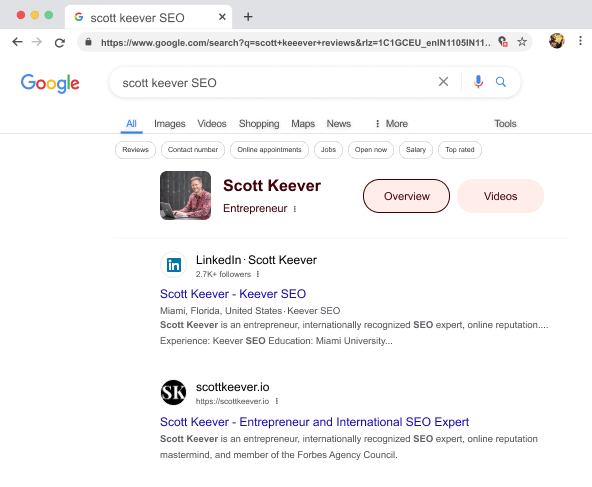
When potential customers Google my name, they see my site above the fold. I control the narrative here.
If someone were to ever research my reputation online, they’d find this:

Again, I’m in control of my image. No one else.
Optimizing your site also protects your image by giving you a place to counteract bad press with the truth. For example, if someone unfairly publishes negative content about you, you can publish a rebuttal on your site that is likely to outrank them.
Optimizing Your Social Media Profiles
Optimizing your social media profiles is another way to proactively protect your brand from negative press where you maximize the visibility of social media sites like Twitter, Linkedin, Facebook, Instagram, and Google My Business. Again, this not only promotes a positive message about your business, it puts you in control of the narrative.
Here is an example of a perfectly optimized social media site for brand reputation:

Claiming All Available Assets
In ORM, claiming all available assets is when you secure all possible digital platforms and other assets that could be associated with your brand name and use them to frame your brand in a positive light.
This includes personal or brand domain names, review sites, industry niche platforms, local business directories, blogging platforms like Medium, and press release platforms.
Taking control of every available platform puts you in control over as much information as possible on the web and protects your brand against harmful attacks.
There are a few key benefits of securing your web presence on all digital platforms:
- It enhances visibility
- It protects your brand
- It makes it more difficult for negative press to rank on Page 1 of Google
- It prevents cybersquatting (third parties taking control of your branded sites or profiles)
- It creates a unified brand image
I find that most of my ORM clients aren’t even aware that securing certain platforms is beneficial. For example, if you Google my name, you’ll see me listed on sites that don’t even occur to the average person. Like this:

Most people don’t think to create profiles on IMDb, WikiAlpha, or Yahoo Finance. But the more real estate I occupy, the less real estate that’s left for people wanting to publish anything about me. Not to mention the brand trust it creates. If someone Googles my name and sees me listed as an SEO and ORM expert on a dozen sites, they’ll believe it’s true.
Publishing Positive Press
Publishing positive press is one of the best ways to enhance your online reputation, build brand trust, and generate more business.
Sharing helpful, newsworthy, or generally positive content is a quick and easy way to gain third-party validation, increase your reach, build a positive brand image, and even market your business all with one tactic. It’s also the best ORM tactic for dominating the search results.
In fact, you should be publishing positive press at all times even if your goal isn’t to protect your brand’s image on the web. It has major downstream implications for SEO, your reputation, and your bottom line.
Say you publish an interesting case study that gets picked up by a major outlet. Now, their entire audience sees your name and visits your site. Once that happens, more people want to visit you, publish your name, and link to you. It’s a massive PR snowball effect that generates positive ROI on auto-pilot.
Google my brand and you’ll find me in Yahoo Finance, the Washington Post, Medium, and Business Insider plus several niche industry sites. I’m constantly sharing SEO tips, achievements, and new business ventures. This brings me more business, improves my credibility, and protects my brand from negative press.
Types of the positive press include:
- Sharing achievements and awards
- Sharing positive case studies
- Publishing new ventures
- Creating thought leadership content for blogs and social platforms
- Creating case studies and testimonials
Implementing schema markup
Schema markup or structured data is a type of data you can add to your website that makes it easier for search engines to understand what your page is about and better present it on the search engine results page.
One simple example of schema markup you’re probably familiar with is star-ratings in customer reviews. Like this:
That five-star rating at the bottom is a simple example of schema markup.
Another type of structured data that improves your online reputation is personal or brand profiles:

Using structured data makes it easy for Google to understand what you’re saying about your brand and present it to searchers in a clean, visual manner.
Google “apple pie recipe” and see what comes up:

This is all schema markup.
Using schema markup is an easy way to proactively enhance your brand’s online reputation for a few reasons:
- It improves your SEO: Using structured data improves your chances of ranking more content on the SERP, giving you more control of your brand image and reducing the chances that negative press ranks on Page 1.
- It improves your business: Ranking on Google with more images, icons, and content in the form of “rich snippets” increases the chances that users will click to your site.
- It improves credibility and trust: Utilizing schema leads to better trust and credibility by confirming your brand message across more platforms. When someone searches your brand online, they’ll see more data displayed on Page 1 saying positive things about you.
Different types of structured data markup I use for clients include:
- Personal data markup
- Organizational data
- Images
- Review ratings
- News (so news articles appear at the top of the search results)
- Local business data displaying an image, location, and working hours if applicable
The goal of a structured schema strategy is to “connect the dots” and improve Google’s confidence in how you present yourself. The more simple data you present to Google about who you are and what you do, the more it gains confidence that you’re telling the truth (and displays you that way on the SERP).
What is Reactive Online Reputation Management
Reactive online reputation management is an ORM method where you address, control, and mitigate negative press, comments, or feedback online. You do this by correcting misinformation, responding to feedback, and publishing positive press to push negativity off of Page 1 of Google.
In other words, it’s immediate crisis management that repairs your damaged reputation.
Reactive crisis management is the quickest and easiest ORM strategy to get bad press to go away and get things back to normal again. I’ve helped countless clients from every walk of life control PR disasters and restore their reputations, even when they were under attack on social media or from major news publications.
You can’t remove the bad press, but you can immediately begin repairing a damaged reputation and start gaining new business by overwhelming the search results with positive information that drowns out the negativity and saves your name.
Some common types of reactive crisis management strategies are :
- Publishing responses to bad press
- Publishing positive media that improves your image
- Pushing up your social media accounts where you post positive media or responses
- Creating new brand assets to outrank the bad press
- Pushing up your company or personal website where you can address the concerns
- Identifying previous positive press and pushing that to the top of the results to outrank the negativity
With enough PR effort, the bad press will drop off Page 1 and your potential customers will only see positive news about you when they search your brand name. Crisis averted.
Important Tip: A damaged reputation can destroy a business. Any type of bad press that shows up for a Google search of your name or business name will immediately scare potential customers away and prevent you from getting any new business. The longer you wait the harder it gets to control a PR crisis. Start repairing your reputation immediately or it could get out of control.
Here’s a quick and simple process I use to help manage a crisis and start repairing your reputation immediately:
How to Repair Your Damaged Reputation Online
Identify Positive Assets You Can Use
The first step in reactive crisis management is to identify all of the positive assets at your disposal you can utilize to start repairing your reputation. Chances are you have a lot more control over your public image than you might think.
Brand assets you can begin mobilizing to manage a crisis are:
- Your company blog or website
- Your social media profiles
- Your YouTube channel or just creating videos for your platforms
- Journalists in your network
- Publications who accept sponsored posts
- Influencers
- Previously satisfied clients
- Forums such as Reddit or quora
- Blog sites like Medium
For example, if a third-party posts negative news about you, one effective tactic is to immediately publish a response proving it to be false on your site, every social page, and YouTube. Then, immediately schedule press releases to major publications addressing the misinformation. This will overwhelm the negative news and turn the press in your favor.
Reverse Engineer Peers to Discover New PR Content Opportunities
Reactive online reputation management requires as much positive press as possible to combat the storm of negativity. The easiest way to discover the best places to publish new content is by looking at your peers or competitors and seeing where their most visible content is published.
If that platform or publication works for your peers, it will work for you too.
When I’m performing crisis management for my clients, one of the first questions I ask is “Who are your peers or competitors”. Then, I find everywhere that the brand is mentioned and build my ORM strategy around that.
Let’s use me as an ORM example again. If someone were looking to improve their brand image in the SEO space, they could use me as a guide. Googling me shows them they should look to create profiles or publish positive media in these places:

Or in these places:

This gives you the best possible chance to repair your reputation as quickly as possible. Instead of searching for new opportunities and taking shots in the dark, you know exactly where to post and if they accept news pieces.
The hard work has been done for you already!
Create an Entity Home
An entity home is a central hub of knowledge about a person, brand, or entity that serves as an authoritative source of information on that topic.
An entity home is like your home address online that displays who you are, what you do, what you offer, and where to contact you (including social profiles).
My entity home is scottkeever.io/about, and I use schema markup to tie all of my social profiles and press releases to it. It “connects the dots” for Google, so to speak. When someone Googles my name, Google knows “This page is about Scott Keever, the SEO guy” and this helps boost that page and all the pages tied to it.
Giving Google this clear understanding of you as an entity is a quick PR win that could pay back huge dividends.
How Can Keever SEO Help Protect Your Online Reputation?
If you’re under attack from negative press, bad reviews, unfair comments, or misinformation campaigns, you need to act immediately by addressing concerns, pushing negative information down, and building your reputation up as quickly as possible.
If you’re suffering any of the following issues, Keever SEO can help repair your reputation ASAP:
- Bad press from lawsuits, business failure, or divorce
- Trouble with police or mugshots
- Social media attacks
- Losing customers or sponsorships
- Employees losing faith in your business
- Difficulties finding positive media opportunities
My team will immediately get to work analyzing the source of the issue, overall public sentiment, and the best opportunities for creating positive media that pushes the negativity out of the public eye.
I specialize in working with high-profile clients like athletes, celebrities, and high net-worth individuals, and I understand that you need unique services tailored specifically to your current situation.
The longer you wait, the worse things are going to get. Just take a deep breath and relax knowing that we’re going to find out the source of the crisis, begin repairing your reputation, and putting a plan in place to monitor things 24/7 so it doesn’t happen again.
We are a multi award-winning agency that has helped hundreds of clients end unfair attacks on their reputation and get their business back to normal again.
Here’s how Keever SEO will solve your online reputation issues and repair your brand name:
- Analyze the crisis: We’ll figure out the source of the crisis, analyze public sentiment, and analyze review scores, search engine rankings, and forum posts to build a plan of action. Once we know what the problem is, we can fix it. It’s like going to the doctor for back pain - once they know the source, they can prescribe the cure.
- Identify positive press opportunities: The next step is to publish as many positive articles as possible on the right outlets to maximize ownership of the results page and push negative articles out of the public eye. We’ve been doing this for 10 years, so we’ve already got a network of journalists and content managers in place ready to accept new media with your good name on it.
- Reverse engineer your peers: My team will get to work analyzing your closest peers and competitors to find opportunities for new outlets we might not be aware of.
- Optimize your existing PR assets: Once we optimize your personal site or company site, social profiles, and review site pages, Google will favor these positive assets over the negative ones and display the information that you want the world to see.
- Leverage our network of websites to build more positive assets: When you’re in crisis, you need the most popular websites to start saying positive things about you to improve your reputation. These ultra “high-authority” sites are the best places to publish good press because they’re so much more visible than smaller, “mom and pop” sites. For example, if I get you published in Forbes, the public is going to see that before they see bad press on a smaller website. Normally, it’s almost impossible to get these publishing opportunities, but since I’ve painstakingly built my network over the years, it’s easy for me.
- Schema markup and technical SEO: My team will implement important structured data across your entire web presence to tie everything together neatly. This will boost all of your assets up and make it easy for Google to display your positive reviews, testimonials, news stories, and company media instead of the bad press.
- SEO campaigns: This is one of the hardest parts of ORM. Once you establish a positive web presence, you need to continually perform SEO and “link building” campaigns to keep “powering up” your positive brand images. By this I mean, you need to consistently publish good press and get other outlets to vouch for your brand image to maintain your positive results in Google and keep the bad results out. If you neglect this, all your hard work could easily be undone.
- Traffic Campaigns: In ORM, you want your positive assets to get more web visitors than your negative ones. It’s simple math. The more visitors an article gets, the more likely it is to rank high in Google. If negative press gets more traffic, it could outrank the positive press. My team will run campaigns that get consistent, high-quality traffic to your positive entities online and boost them over anything negative about you. Once we signal to Google to favor positive news over negative press, Google will rank the good articles over the bad ones. Plain and simple.
Reactive ORM Crisis Management Case Studies - How Keever SEO Helped Save The Reputations of an Actor, Athlete, and Business Mogul
We are an award-winning ORM firm that specializes in helping high-profile clients take control of crises and repair their brand reputation. If damaging content online is hurting your brand, business, and partnerships, contact us immediately and we will take back control of the narrative, restore your reputation, and get your business back to normal as soon as possible.
Here are a few recent examples of reactive ORM we performed here at Keever SEO where we pushed negative results out of the spotlight, repaired the client’s online presence, and created an authentic reputation of their personal brand DESPITE the negative press from high-profile news publications.
Multi-Billionaire PR Crisis From The Guardian and AP News
Recently, one multi-billionaire business mogul approached us with a major PR issue: Negative press from several large publications was dominating the search results. He was under fire from The Guardian, AP News, and several smaller publications. This damaging content was doing intense harm to their brand, ruining their business, and hurting potential partnerships.
These high stakes required quick action and specialized planning from my team.
My team went to work mitigating the damage and creating a positive, authentic representation of the businessman. Here’s how we repaired his reputation quickly:
- We analyzed the negative press to create a plan of action
- We cataloged existing positive content to see which would be best to boost above the negative press
- Then, we exponentially increased traffic to the positive news to signal to Google to rank it above the damaging content
- Next, we powered up his social profiles and brand assets to push them up the rankings
- We then connected all of his profiles, site, and positive press using schema markup so Google could easily read, understand, and display it
- Finally, we created an SEO campaign to send traffic and links to existing positive assets. Since his positive assets now had more traffic, links, and freshness (Google prefers new content), all of the positive news outranked the negative press
The result? We removed 4 negative stories from Page 1 and the results are now dominated by fair, accurate, and positive media that has put an end to the media storm and repaired his image.
Actor in Crisis Mode Removes Negative Media And Restores His Acting Career
A popular actor facing a PR nightmare contacted us because negative content was preventing him from getting high-paying acting roles. To make his PR nightmare worse, the stories were from ultra-high-profile publications like Rolling Stone and VanityFair. So they were even more visible and “trustworthy” to the general public.
This could very well have ruined his acting career.
Using many of the techniques featured above as well as proprietary techniques for images, SEO, and link-building, we were able to push the damaging content out of the public eye.
We even managed to remove a clickbait video with unfair opinions.
Now, search results for his name are totally clean, fair, and positive. This has allowed him to once again obtain high-profile acting roles and move on from this crisis.
Removing Damaging Content From Sports Websites For a High-Profile Athlete Under Media Scrutiny
This ORM case study featured some of the most difficult ORM work we’ve done.
This athlete was under intense media scrutiny from several major publications such as Bleacher Report and Yahoo Sports. This added fuel to the fire because those sites have heavy traffic and links which kept them prominently displayed in Google’s results.
Not only were the results for his name dominated by harmful allegations, results for his name plus his team’s name also featured damaging media stories. And since the stories were from ultra high-authority sites like Bleacher Report with major reach, this would require intense SEO campaigns to repair the damage.
Thankfully, we have extensive experience in exactly this type of PR work, so it was just a matter of planning and execution.
Once we set a benchmark, we did the following:
- Created a campaign to send a higher number of traffic and links to positive assets, signaling to Google that the positive assets were favorable to the negative ones
- Used our existing network of high-authority sites to begin a PR campaign that resulted in 8 new positive pieces being published by trustworthy sites
- We optimized all of the athlete’s existing assets so that they featured prominently in Google’s results - much higher than they did before
- We acquired several scholarship sites in the athlete’s name to offer $1,000 or more to students. This resulted in high-authority links from colleges and universities as well as positive press that powered up his existing assets
- Finally, we began SEO campaigns to his existing assets such as social media profiles so they outranked the damaging content
The result?
We successfully pushed the negative content off of Page 1 to lower pages where they now receive almost no traffic.
This extended campaign by Keever SEO has completely transformed the athlete’s online presence and restored their reputation. He now has more partnerships, and more importantly, more peace of mind.
Online Reputation Management F.A.Q
Is Online Reputation Management The Same as SEO?
No online reputation management is not the same as SEO. Search engine optimization is the discipline concerned with optimizing one site and moving it up the Google search rankings whereas ORM is focused on filling the entire front page of Google with positive content. This positive content could be from social media profiles, news outlets, a personal or company website, or any number of other sources. It’s essentially 10 different SEO campaigns.
Is Online Reputation Management The Same as SEO?
No online reputation management is not the same as SEO. Search engine optimization is the discipline concerned with optimizing one site and moving it up the Google search rankings whereas ORM is focused on filling the entire front page of Google with positive content. This positive content could be from social media profiles, news outlets, a personal or company website, or any number of other sources. It’s essentially 10 different SEO campaigns.
How Can I Monitor My Online Reputation Effectively?
You can monitor your online reputation by using tools such as Google Alerts, Mention, HootSuite, and SEMRush. You must also consistently monitor your social media profiles and review aggregator sites, being sure to respond promptly to negative reviews and engage with your audience daily.
What Should I Do if I Receive a Negative Review or Comment?
When you receive a negative review or comment, be sure to respond promptly and professionally and to address the customer’s concerns or provide a solution. Customers respond positively when given an apology, an avenue for recourse, and the next steps to resolving an issue. Even just having a response apologizing for the issue and offering a resolution has been demonstrated to be effective at improving public sentiment.
What Are Some of the Best Ways to Maintain a Positive Reputation Online?
The best ways to maintain a positive reputation online are by practicing proactive ORM strategies like engaging with your audience on social media, regularly monitoring your internet reputation, publishing positive content that enhances your brand image, and implementing an ongoing SEO strategy that pushes brand-friendly content to the top of the Google results page.
How Can I Fix My Reputation Online?
You can repair your reputation online by doing the following: Identifying the source of the crisis, identifying all of the positive assets at your disposal, optimizing your assets like your company website and social profiles, implementing an SEO campaign to boost those assets up in the Google rankings, and publishing positive content about your brand on reputable news websites. You can also encourage existing customers and connections to leave positive reviews on your social media profiles, review aggregators, and Google My Business page.


